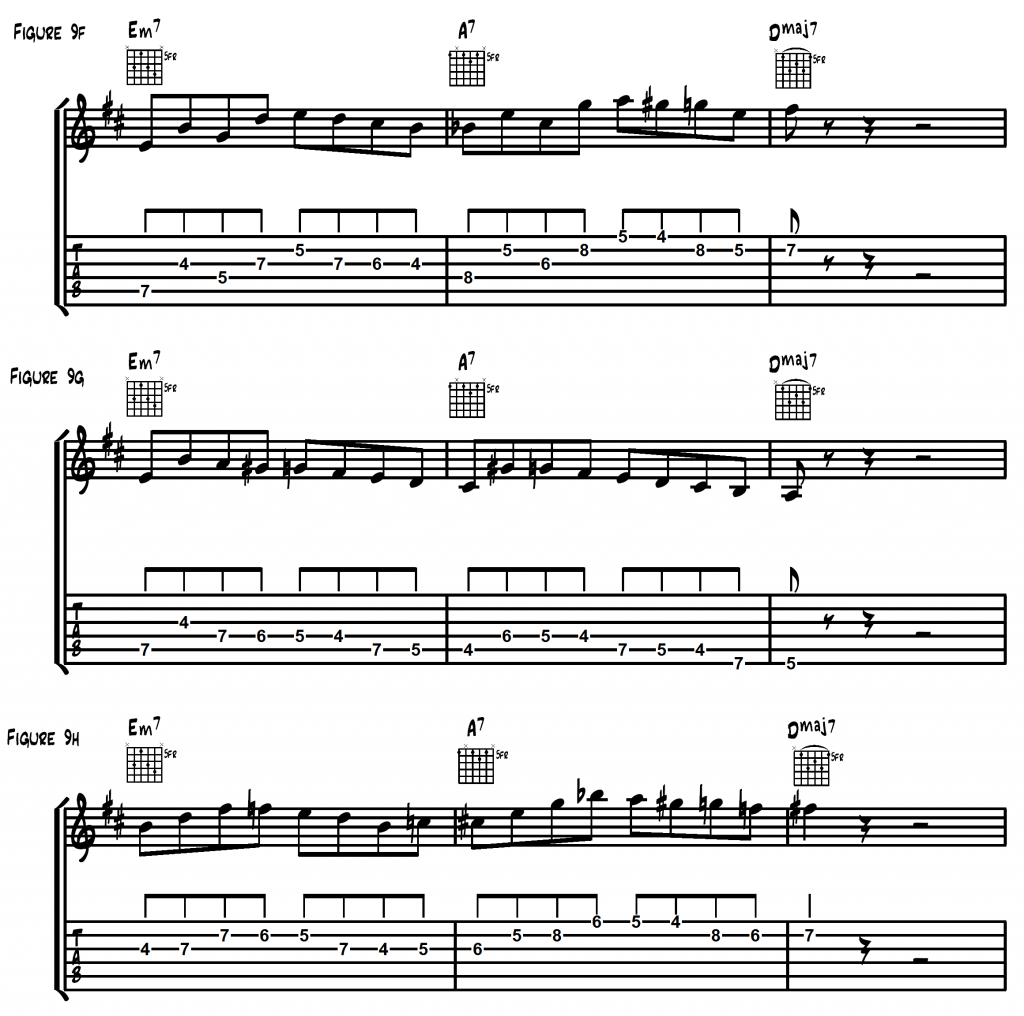Combining Arpeggios with the Bebop Scale
The following is an extract from my book Fundamental Changes in Jazz Guitar
We’ve done a lot of work with arpeggios and the bebop scale. It’s now time to combine the two devices for a musical, articulate sound. To do this we’re going to start by ascending arpeggios from each chord tone and then de-scending the bebop scale. This is a common sound and you can use it to write your own lines and licks.
Once again we start our structured approach by ascending the E minor 7 arpeggio from the root to b7. We then descend 4 notes down the bebop scale to land on ‘G’ the b7 of A7. We ascend the Bb diminished arpeggio to the octave of the b7 (G) and we then descend the bebop scale to land on the major 7th of the D Major Chord (C#), finally jumping down to the A for a real bebop flavor. This is shown in figure and audio example 9a.
Next we begin on the b3 of the E minor (G) and ascend the arpeggio to the 5th (B) and descend the bebop scale again until we hit the b7 of A7. We descend the Bb diminished arpeggio to the b9 of A7 and continue scalically down the bebop scale with a little bounce off to the 3rd of D Major. Study figure and audio example 9b.
Figure and audio example 9c is another example from the 3rd of E minor that hits the 3rd of A7 and a chromatic approach note pattern into the 3rd of the D Major:
Figure and audio example 9d ascends from the 5th of E minor 7, ascend the arpeggio from the 5th to the 3rd, play the A on the top string and descend the bebop scale to the 5th of A7 (E) Here we play a chromatic approach note into the 3rd and descend via the b9 and bebop scale with a cool little chromatic jump to the 3rd of the D Major 7.
Figure and audio example 9e is an example from the b7 of the E minor: Ascend the arpeggio from b7 to b3, de-scend the bebop scale. Chromatically approach the 5th of the A7 chord (E) Ascend the Bb diminished arpeggio to the 5th again and descend to the 5th of the D major 7 chord.
I’ve given you one or two examples for each arpeggio tone but I expect you’re anxious to create your own lines and make your own play-ing unique and fluid.
How can you be creative with this important concept?
It is an important stage to learn and play the lines above with confidence as they’re a great place to start. There is a reason I have written out the theory behind the construction of the lines; it’s so you understand what’s happening technically to help develop your own voice.
Have patience and determination to learn and understand these lines before embarking on your own voyage of discovery.
When I was writing these ideas I sat with my guitar and said to myself; ‘ok what happens when I ascend 4 notes up an arpeggio and descend a bebop scale?’ Then I spent some time figuring out some lines. I didn’t stick to this rule too hard as you’ll see if you really study the lines above. This was however my starting point and everything developed naturally from there.
When you’re writing your own lines how about these ideas to get you going?
Ascend 3 notes up an arpeggio and descend the bebop scale. Ascend 4, ascend 5 etc.
- Skip intervals, in-stead of 1, b3, 5, b7, try 1, 5, b3, 7, figure and audio example 9f.
- Skip intervals 1 – 5 and then descend the bebop scale , figure and audio example 9g.
- Add in chromatic approach note patterns, figure and audio example 9h.
- Begin on beat 2, beat 3 or beat 4
9F
9G
9H
- Play a chromatic approach note on the off-beat before your first arpeggio tone, figure and audio example 9i
There are so many possible combinations so for now just pick one idea at a time. If you like it write it down, there’s blank music paper at the back of this book to get you started and lots of free resources online for printing your own paper.
Remember, there is no way to cram in every idea in every lick. Keep it simple for now and try to think of this lesson as a chance to internalize the sound of the bebop scale in conjunc-tion with arpeggios.
Have fun!….
“The artists you work with, and the quality of your work speaks for itself.”
Tommy Emmanuel
© Copyright Fundamental Changes Ltd 2025
No.6 The Pound, Ampney Crucis, England, GL7 5SA







